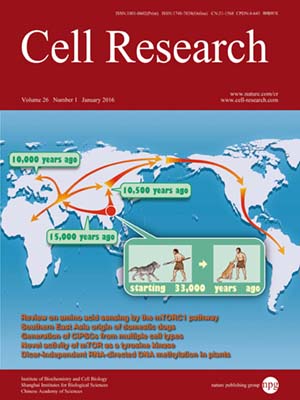
Volume 26, No 1, Jan 2016
ISSN: 1001-0602
EISSN: 1748-7838 2018
impact factor 17.848*
(Clarivate Analytics, 2019)
Volume 26 Issue 1, January 2016: 135-138
LETTERS TO THE EDITOR
Birth of fertile bimaternal offspring following intracytoplasmic injection of parthenogenetic haploid embryonic stem cells
Zhikun Li1,2,*, Haifeng Wan1,*, Guihai Feng1,3,*, Leyun Wang1,4,*, Zhengquan He1, Yukai Wang1, Xiu-Jie Wang3, Wei Li1, Qi Zhou1 and Baoyang Hu1
1State Key Laboratory of Stem cell and Reproductive Biology, Institute of Zoology, Chinese Academy of Sciences, Beijing 100101, China
2University of Chinese Academy of Sciences, Beijing 100049, China
3Key Laboratory of Genetic Network Biology, Institute of Genetics and Developmental Biology, Chinese Academy of Sciences, Beijing 100101, China
4College of Life Science, Northeast Agricultural University of China, Harbin, Heilongjiang 150030, China
Correspondence: Baoyang Hu, E-mail: byhu@ioz.ac.cn; Qi Zhou, E-mail: qzhou@ioz.ac.cn; Wei Li,(liwei@ioz.ac.cn)
Normal mammalian development requires participation of both maternal and paternal genomes because of the existence of genomic imprinting, whereas the gynogenetic and androgenetic embryos die shortly after implantation1,2,3. Generation of gynogenetic bimaternal mice containing two sets of maternal genomes was achieved using non-growing oocytes with imprinting modifications4; however, the approach was technically challenging and impractical for further applications. Recently, we and others have derived mammalian androgenetic and parthenogenetic haploid embryonic stem cells (ahESCs and phESCs), and showed that ahESCs can replace gametes to produce offspring5,6,7, which provided alternative resources for reproduction6,7. Here we report that after proper imprinting modifications, the mouse phESCs can efficiently produce viable fertile offspring upon intracytoplasmic injection into MII oocytes. We thus establish a novel strategy of generating bimaternal mammals, which is valuable to uncover the function of genomic imprinting, and to improve assisted reproduction in diverse mammalian species.
10.1038/cr.2015.151
FULL TEXT | PDF
Browse 3321


